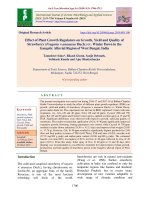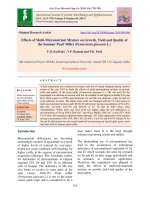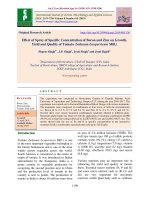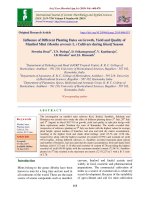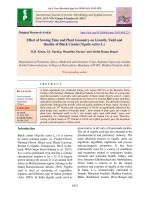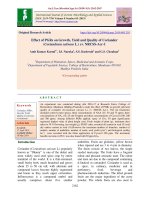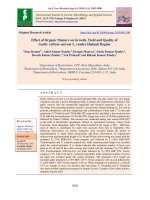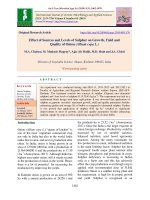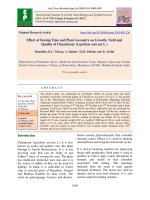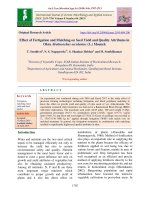Influence of different planting dates on growth, yield and quality of menthol mint (Mentha arvensis L.) cultivars during Kharif season
Bạn đang xem bản rút gọn của tài liệu. Xem và tải ngay bản đầy đủ của tài liệu tại đây (445.26 KB, 11 trang )
Int.J.Curr.Microbiol.App.Sci (2019) 8(6): 468-478
International Journal of Current Microbiology and Applied Sciences
ISSN: 2319-7706 Volume 8 Number 06 (2019)
Journal homepage:
Original Research Article
/>
Influence of Different Planting Dates on Growth, Yield and Quality of
Menthol Mint (Mentha arvensis L.) Cultivars during Kharif Season
Shwetha Desai3*, T.N. Pushpa3, D. Srikantaprasad3, V. Kantharaju1,
I.B. Biradar2 and J.S. Hiremath3
1
Department of Pathology and Head (AICRP Tropical Fruits), K. R. C. College of
Horticulture, Arabhavi – 591 218, University of Horticultural Sciences, Bagalkot – 587 102,
Karnataka, India
2
Department of Agronomy, K. R. C. College of Horticulture, Arabhavi – 591 218, University
of Horticultural Sciences, Bagalkot – 587 102, Karnataka, India
3
Department of Plantation, Spices, Medicinal and Aromatic Crops, K. R. C. College of
Horticulture, Arabhavi – 591 218, University of Horticultural Sciences, Bagalkot – 587 102,
Karnataka, India
*Corresponding author
ABSTRACT
Keywords
Menthol mint,
Planting dates,
Cultivar, Net
returns, B: C ratio
Article Info
Accepted:
07 May 2019
Available Online:
10 June 2019
The investigation on menthol mint cultivars Kosi, Kushal, Sambhav, Saksham and
Himalaya was carried out to study the effect of different planting dates (5 th July, 20th July
and 5th August) in kharif 2017-18 on growth, yield and quality in split plot design with
three replications under Northern dry zone of Karnataka. The results revealed that,
irrespective of cultivars, planting on 5th July was better with the highest values for average
plant height, spread, number of branches, leaf area and total dry matter accumulation,
resulting in the highest fresh and shade dried herbage yield (15.76 and 11.90 t/ha,
respectively) along with the highest essential oil content (0.79%) and essential oil yield
(95.44 kg/ha). Among different cultivars cv. Sambhav recorded maximum plant spread
and number of branches, leaf area and total dry matter accumulation, fresh and shade dried
herbage yield (13.53 and 11.10 t/ha) and essential oil content (0.78) providing the highest
essential oil yield (88.48 kg/ha) with the maximum menthol content (72.06 %). Sambhav
planted on 5th July resulted in the maximum net returns (₹ 93,227 ha-1) with a B: C ratio
of 2.76.
carvone, linalool and linalyl acetate used
widely in food, cosmetic and pharmaceutical
preparations. The commercial cultivation of
mints as a source of essential oils is relatively
recent development. Because of the suitability
of agro-climate and soil for mint cultivation
Introduction
Mints belong to the genus Mentha have been
known to man for a long time and are used in
all continents of the world. These are the main
source of aroma compounds such as menthol,
468
Int.J.Curr.Microbiol.App.Sci (2019) 8(6): 468-478
as an annual crop, India has become the major
supplier of menthol mint oil to the
international market. However, menthol mint
remains the principal cultivated mint in India
(Varshney, 2011). Menthol mint is valuable
commercially because of its high oil yield and
the menthol content. Leaves and stems are
known to contain about 0.6 per cent oil which
has 70-85 per cent menthol in it.
Arabhavi is considered to have the benefit of
both south-west and north-east monsoons.
During experiment, crop received about 359.6
mm of rainfall, (July – December 2017), the
mean temperature and mean relative humidity
(RH) ranged from 26.15°C and 91.10 per cent
(July 2017) to 22.10°C and 78.00 per cent
(December 2017), respectively. The soil of
experimental site is sandy clay loam
(vertisols) with alkaline pH (8.79).
The geographical areas of India, where all the
rice, wheat, potato and sugarcane crops can be
cultivated, are suitable for mint farming also.
In India, it is commercially grown in subtropical plains as a summer season crop after
the harvest of winter season crops viz., potato,
mustard and pea etc. In Northern dry zone of
Karnataka, not much research work has been
carried out on menthol mint, there is a need
for development of package of practices for
its large scale cultivation for betterment of the
farming community. Planting dates and
cultivars are the major factors that influence
the growth, development and yield of the
crop. Indian monsoon is very erratic and
uncertain. More than 70 per cent of the
cultivated area of menthol mint in India is
affected by early onset of monsoon (Singh,
2005 and Singh et al, 2008). Hence, the
present research programme is planned to
select the suitable planting date and cultivars
for high herbage, essential oil yield in
Northern dry zone of Karnataka.
Experimental details
The experiments were laid out in split-plot
design with three replications, considering
planting dates as main treatments(5th July, 20th
July and 5th August) and cultivars as sub
treatments (Kosi, Kushal, Sambhav, Saksham
and Himalaya).
The experimental site was brought to fine tilth
by ploughing deeply with tractor drawn
reversible double mouldboard plough. Then
the plots of 3.6 m width and 4.5 m length
were laid out and separated by bunds of 60
cm width as per the plan making provision for
irrigation channels. The plants were uprooted
and white stolons of uniform thickness were
separated. They were cut into of 7.0 to10.0
cm long cuttings having 2-3 nodes and dipped
in 0.3 per cent COC for 5-10 minutes before
planting. The furrows were opened at 45 cm
interval in each plot. Prepared stolons were
placed horizontally in mid of furrows at 30
cm spacing, at a depth of 2.5 to 4.0 cm and
later covered with soil. Irrigation was given
immediately after planting and subsequent
irrigations were given at eight to ten days
intervals depending on the rainfall and soil
moisture. The crop was harvested at 120 days
after planting when the crop was at fifty per
cent flowering.
Materials and Methods
The present investigation was carried out
during 2017-2018 for kharif season in the
Department of Plantation, Spices, Medicinal
and Aromatic Crops, Kittur Rani Channamma
College of Horticulture, Arabhavi, University
of Horticultural Sciences, Bagalkot situated in
northern dry zone (Zone No. 3; Region-2) of
Karnataka at 16°15’ N latitude and 74°45’ E
longitude, at an altitude of 612 m above mean
sea level.
Observations on growth parameters like plant
height, spread and number of branches and
were recorded on five randomly selected
469
Int.J.Curr.Microbiol.App.Sci (2019) 8(6): 468-478
plants in each replication of different
treatments at and at harvest. The leaf area was
calculated on five randomly selected plants by
using Biovis instrument at harvest. For total
dry matter accumulation, the selected five
plants were uprooted from soil and the
different plant parts like leaves, stem and
roots were separated and dried in oven for 15
hrs at 60°C. The average weight of leaves,
stem and roots per plant was weighed on
balance and expressed in grams. The fresh
herbage yield was recorded in each plot at the
time of harvest. Then fresh yield per hectare
was calculated on the basis of fresh herbage
yield per plot. The fresh herbage from net plot
dried in shade for 3-4 hours. The shade dried
herbage yield was calculated on the basis of
shade dried herbage yield per plot. Known
weight of fresh herbage from each plot was
taken and withered for few hours in shade.
The plant material was chopped into small
pieces and essential oil extraction was done
by hydro-steam distillation method using
essential oil extraction unit of 10 kg capacity
(CSIR – Institute of Himalayan Bioresource
Technology patented technology). Essential
oil content was estimated on shade dried
weight and menthol content was estimated by
using gas chromatography.
and critical difference (CD) values were
worked out wherever ‘F’ test was significant.
Results and Discussion
Growth parameters
The growth parameters were significantly
influenced by planting dates at harvest. Early
planting on 5th July 2017 recorded maximum
plant height (73.57 cm) plant spread (55.93
cm) and maximum number of branches
(30.09) compared to the late planting on 5th
August 2017 which recorded minimum height
(50.60 cm), spread (37.09 cm) and minimum
branches
(20.61).
Increased
growth
parameters with early planting could be
attributed to favourable weather conditions
which might have influenced the plants to
grow taller by increasing cell division and cell
elongation Kurian and Sankar (2007). Similar
findings were observed by Nilofer et al.,
(2015) in menthol mint, Sharma and Kanjilal
(1999) in pepper mint, Mohammad et al.,
(2010) in German chamomile, Ram et al.,
(2010) and Shamaraj et al., (2010) in
ashwagandha, Sunil et al., (2011) and Krishna
et al., (2014) in kalmegh, Seghatoleslami et
al., (2013) in roselle, Kumar et al., (2017) in
basil. The reasons for increased
The price of the inputs that prevailing during
experiment was considered for working out
the economics of the various treatment
combinations. Cost of cultivation was
computed as per treatments. Gross returns
were worked out based on the market price of
the produce.
growth parameters during early planting
might be due to crop planted on 5th July 2017
did not affected much by heavy rainfall
during establishment stage as compared to
latter planting as 20th July 2017 and 5th
August 2017 planting dates received higher
rainfall during establishment and growth
stages resulted in slow growth (Fig. 1).
Net returns per hectare were calculated by
deducting the cost of cultivation from gross
returns per hectare. The benefit cost ratio was
worked out for different treatments. Fisher
method of analysis of variance as given by
Panse and Sukhatme (1967) was applied for
analysis and interpretation of data. The level
of significance used in ‘F’ test was at P = 0.05
Different cultivars of menthol mint
irrespective of planting dates recorded
significantly different growth parameters at
all stages of crop growth. At harvest among
the different cultivars cv. Kushal recorded
maximum plant height (63.19 cm), cv.
470
Int.J.Curr.Microbiol.App.Sci (2019) 8(6): 468-478
(4833.84 cm2) and total dry matter
accumulation (136.13 g/plant) at harvest
compared to crop planted on 5th August 2017
which produced minimum leaf area (2377.24
cm2) and total dry matter accumulation
(104.62 g/plant). Higher leaf area might be
due congenial weather conditions during that
period which could be attributed to the
increased growth expressed by increased
number of branches and more plant spread
which determines the photosynthetic ability,
growth and further dry matter production.
Similar findings were observed by Nilofer et
al., (2015) in menthol mint, Solanki and
Shaktawat (1999) in isabgol, Agarwal et al.,
(2004) in ashwagandha, Okosun et al., (2006)
in roselle, Singh and Singh (2006) in
kalmegh, Shamaraj et al., (2010) in
ashwagandha (Table 2).
Saksham recorded minimum plant height
(56.29 cm). At same time, cv. Sambhav
recorded maximum plant spread (49.09 cm)
and number of branches (27.12) compared to
cv. Saksham which recorded minimum plant
spread (39.47 cm), number of branches
(22.90). The increased plant spread and in cv.
Sambhav may be due to vigorous growth.
Further increased spreading resulted in
maximum branches. Change in geographical
location or inherent genetic variations could
be the major reason for variation in growth
parameters among different cultivars. The
present results are in contrary to the findings
of Nilofer et al., (2015), Lal (2013) where cv.
Kosi was superior in terms of growth
attributes (Table 1).
Interaction between dates of planting and
cultivars had significant influence on growth
parameters at harvest. The cv. Kushal planted
on 5th July 2017 registered maximum plant
height (78.40 cm), cv. Saksham planted on 5th
August 2017 which recorded minimum plant
height (46.80 cm) which might be attributed
to synergistic effect of planting date and
cultivar which contributed to highest plant
height. Among the different interactions, cv.
Sambhav on 5th July 2017 (P1V2) registered
maximum plant spread (58.93 cm), number of
branches (33.83) compared to cv. Saksham
planted on 5th August which recorded
minimum plant spread (32.45 cm), number of
branches (18.40). This might be attributed to
combined effect of planting date and cultivar
that resulted in increased plant spread there by
more number of lateral buds leading to more
number of branches. These results are in line
with findings of Ram et al., (2000), Chauhan
et al., (2011) and Sharma (2012) in menthol
mint.
Physiological parameters were significantly
varied with different cultivars. At harvest,
among the different cultivars, cv. Sambhav
recorded maximum leaf area (4216.67
cm2/plant) and total dry matter accumulation
(147.11 g/plant) compared to cv. Saksham
which recorded minimum leaf area (2720.33
cm2/plant) and total dry matter accumulation
(97.02 g/plant). The maximum physiological
parameters in cv. Sambhav might be
attributed to increased number of branches
and more plant spread. However variation in
physiological parameters might be due to the
varietal characteristics and response of trait to
environmental condition. The present results
are in contrary to the findings of Chauhan et
al., (2011) and Nilofer et al., (2015) where cv.
Kosi was superior in terms of growth
attributes. Physiological parameter like leaf
area varied significantly with the interaction
of dates of planting and cultivars at all stages
of crop growth. Among the different
interactions, cv. Sambhav planted on 5th July
2017 registered maximum leaf area (6035.54
cm2/plant) compared to cv. Saksham planted
on 5th August 2017 which recorded minimum
Physiological parameters
Menthol mint planted on 5th July 2017
significantly recorded maximum leaf area
471
Int.J.Curr.Microbiol.App.Sci (2019) 8(6): 468-478
leaf area (1639.93 cm2/plant). Higher leaf
area might be due congenial weather
conditions during that period which could be
attributed to the increased growth expressed
by increased number of branches and more
plant spread and also due to favourable
influence of planting date and cultivars which
resulted in maximum leaf area.
oil content in delayed planting was on account
of heavy rains during maturity time, which
ruptured and washed off oil glands of leaves.
The results are in line with those findings by
Sharma (2012) and Nilofer et al., (2015) in
menthol mint. The influence of planting dates
was found nonsignificant with respect to
menthol content.
Yield and quality parameters
Different cultivars of menthol mint
irrespective of planting dates recorded
significantly different yield parameters. At
harvest, cv. Sambhav recorded maximum
fresh herb yield (13.53 t/ha), shade dried
herbage yield (11.10 t/ha), oil content (0.78
%) and essential oil yield (88.48 kg/ha)
compared to cv. Saksham which recorded
minimum fresh herb yield (9.60 t/ha), shade
dried herbage yield (7.84 t/ha), oil content
(0.63 %) and essential oil yield (51.37 kg/ha).
The average menthol content of menthol mint
was significantly influenced by the cultivars.
Cultivar Sambhav recorded maximum
menthol content (72.06 %), whereas
minimum was noticed in cv. Himalaya (70.41
%).
Menthol mint planted on 5th July 2017 was
significantly superior in terms of fresh
herbage yield (15.76 t/ha), shade dried
herbage yield (11.90 t/ha) and essential oil
yield (95.44 kg/ha) while minimum fresh
herbage yield (9.13 t/ha), shade dried herbage
yield (8.23 t/ha) and essential oil yield (52.71
kg/ha) was recorded by planting on 5th August
2017.
This might be due to increased leaf area
which might have produced and translocated
more photosynthates resulting in better plant
growth in terms of plant height, plant spread
and number of branches resulting in higher
fresh herb, shade dried herb and essential oil
yield. These findings are in agreement to
those reported by Sharma (2012), Nilofer et
al., (2015) in menthol mint, Sarma and
Kanjilal (2000) in patchouli, Mann and Vyas
(2001) in isabgol, Castro et al., (2004) in
roselle, Jyoti et al., (2009) in coleus, Sadeghi
et al., (2009) in basil, Shamsi (2009) in milk
thistle. Krishna et al., (2014) in kalmegh.
The possible reason for the increase in fresh
herb weight could be due to higher growth
attributes viz., plant spread and number of
branches, physiological attributes like leaf
area and total dry matter accumulation there
by more fresh and shade dried herb weight
which leads to increased oil content and
essential oil yield. Majority of the workers
had the idea that yield potential was varietal
character. The present results are in contrary
to the findings of Kumar et al., (2000),
Chauhan et al., (2011), Lal (2013) and Nilofer
et al., (2015), where cv. Kosi was superior in
terms of yield and quality attributes.The effect
of interaction between cultivars and planting
date found nonsignificant on yield and quality
parameters (Table 3 and 4).
Oil content was significantly influenced by
dates of planting at all stages of growth. At
harvest, early planting on 5th July 2017
recorded maximum oil content (0.79 %)
compared to the late planting on 5th August
2017 (0.63 %). It was due to favourable
weather conditions required for crop i.e.
optimum temperature and relative humidity
and these factors enhanced the ratio of leaves
to stem resulting in higher oil content. Lower
472
Int.J.Curr.Microbiol.App.Sci (2019) 8(6): 468-478
Table.1 Influence of dates of planting on growth parameters of menthol mint (Mentha arvensis L.) cultivars at harvest (120 DAP)
Treatments
V1
72.87
P1
50.07
P2
47.37
P3
Mean
56.77
For comparison of mean
V2
78.40
57.97
53.20
63.19
Planting dates(P)
Varieties (V)
V at same level of P
P at same or different
level of V
Plant height (cm)
V3
V4
75.33
69.80
56.10
52.27
52.73
46.80
61.38
56.29
S.Em ±
0.76
0.64
1.11
6.25
Main plot treatments (P)
P1: 5th July P2: 20th July P3: 5th August
DAP: Days after planting
V5
71.47
51.20
52.90
58.52
Mean
73.57
53.52
50.60
CD @ 5 %
2.97
1.87
3.25
20.54
V1
55.92
38.22
34.90
43.01
Growth parameters
Plant spread (E-W and N-S) (cm)
V2
V3
V4
V5
58.02
58.93
50.40
56.40
46.57
47.53
35.58
38.65
39.43
40.83
32.45
37.85
48.00
49.09
39.47
44.30
S.Em ±
0.71
0.60
1.04
5.83
Mean
55.93
41.31
37.09
CD @ 5 %
2.78
1.75
3.02
19.19
V1
28.17
23.40
20.27
23.94
V2
33.03
24.83
21.30
26.38
Number of branches
V3
V4
V5
33.83
27.13
28.30
25.50
23.17
24.60
22.03
18.40
21.07
27.12
22.90
24.65
S.Em ±
0.35
0.34
0.59
3.17
CD @ 5 %
1.39
0.99
1.72
10.24
Sub plot treatments (V)
V1: Kosi, V2: Kushal, V3: Sambhav, V4: Saksham and V5: Himalaya
Table.2 Influence of dates of planting on physiological parameters of menthol mint (Mentha arvensis L.) cultivars at harvest (120
DAP)
Treatments
V1
4413.32
P1
2879.85
P2
2338.76
P3
Mean
3210.64
For comparison of mean
V2
5314.74
3212.97
2714.57
3747.42
Planting dates(P)
Varieties (V)
V at same level of P
P at same or different level of V
Main plot treatments (P)
P1: 5th July P2: 20th July P3: 5th August
DAP: Days after planting
Leaf area (cm2/plant)
V3
V4
6035.54
3914.34
3855.40
2606.72
2759.09
1639.93
4216.67
2720.33
S.Em ±
45.58
102.48
177.50
825.87
V5
4491.29
3145.71
2433.88
3356.96
Mean
4833.84
3140.13
2377.24
CD @ 5 %
178.96
299.12
518.09
2473.92
Sub plot treatments (V)
V1: Kosi, V2: Kushal, V3: Sambhav, V4: Saksham and V5: Himalaya
473
V1
133.33
102.33
88.77
108.14
Total dry matter accumulation (g/plant)
V2
V3
V4
V5
137.67
161.00
111.33
137.33
144.33
147.67
97.40
100.67
130.00
132.67
82.33
89.33
137.33
147.11
97.02
109.11
S.Em ±
3.87
3.58
6.21
33.85
CD @ 5 %
15.21
10.46
NS
NS
Mean
136.13
118.48
104.62
Mean
30.09
24.30
20.61
Int.J.Curr.Microbiol.App.Sci (2019) 8(6): 468-478
Table.3 Influence of dates of planting on yield parameters of menthol mint (Mentha arvensis L.) cultivars at harvest (120 DAP)
Treatments
V1
15.51
P1
11.21
P2
8.61
P3
Mean
11.78
For comparison of mean
V2
16.58
12.50
9.24
12.77
Fresh herbage yield (t/ha)
V3
V4
V5
17.98
13.55
15.16
12.70
8.26
9.91
9.91
6.97
10.92
13.53
9.60
12.00
S.Em ±
0.36
0.35
0.61
3.29
Planting dates(P)
Varieties (V)
V at same level of P
P at same or different level of V
Main plot treatments (P)
P1: 5th July P2: 20th July P3: 5th August
DAP: Days after planting
Mean
15.76
10.92
9.13
Shade dried herbage yield (t/ha)
V2
V3
V4
12.62
13.77
10.22
10.00
10.85
6.60
8.29
8.69
6.70
10.30
11.10
7.84
V1
11.43
8.96
7.82
9.40
CD @ 5 %
1.43
1.03
NS
NS
S.Em ±
0.42
0.29
0.50
3.09
V5
11.49
7.78
9.65
9.64
Mean
11.90
8.83
8.23
CD @ 5 %
1.67
0.84
NS
NS
Sub plot treatments (V)
V1: Kosi, V2: Kushal, V3: Sambhav, V4: Saksham and V5: Himalaya
Table.4 Influence of dates of planting on oil content, oil yield and menthol content of menthol mint (Mentha arvensis L.) cultivars at
harvest (120 DAP)
Treatments
V1
V2
0.77 0.86
P1
0.70 0.72
P2
0.62 0.66
P3
Mean
0.69 0.74
For comparison of mean
Planting dates(P)
Varieties (V)
V at same level of P
P at same or
different level of V
Oil content (%)
V3
V4
0.90 0.66
0.77 0.65
0.69 0.60
0.78 0.63
S.Em ±
0.02
0.01
0.02
0.12
Main plot treatments (P)
P1: 5th July P2: 20th July P3: 5th August
DAP: Days after planting
V5
0.78
0.67
0.61
0.68
Mean
0.79
0.70
0.63
CD @ 5 %
0.07
0.03
NS
NS
V1
89.29
63.44
49.25
67.32
V2
108.42
69.27
54.78
77.49
Oil yield (kg/ha)
V3
V4
121.59 67.76
83.89 45.14
59.96 41.21
88.48 51.37
S.Em ±
3.31
2.15
3.73
23.50
V5
90.15
54.07
58.35
67.52
Mean
95.44
63.16
52.71
CD @ 5 %
12.99
6.29
NS
NS
Sub plot treatments (V)
V1: Kosi, V2: Kushal, V3: Sambhav, V4: Saksham and V5: Himalaya
474
V1
71.87
71.11
70.43
71.13
Menthol content (%)
V2
V3
V4
V5
71.20 72.92 71.42 71.46
70.52 71.41 70.63 70.20
70.92 71.85 70.75 69.58
70.88 72.06 70.93 70.41
S.Em ±
0.32
0.27
0.47
2.62
Mean
71.77
70.77
70.70
CD @ 5 %
NS
0.79
NS
NS
Int.J.Curr.Microbiol.App.Sci (2019) 8(6): 468-478
Table.5 Economics of cultivation as influenced by interaction of dates of planting and cultivars
of menthol mint (Mentha arvensis L.)
Treatments
P 1V 1
P 1V 2
P 1V 3
P 1V 4
P 1V 5
P 2V 1
P 2V 2
P 2V 3
P 2V 4
P 2V 5
P 3V 1
P 3V 2
P 3V 3
P 3V 4
P 3V 5
Main plot treatments (P)
P1: 5th July
P2: 20th July
P3: 5th August
Cost of cultivation
(₹/ha)
50,210.40
51,281.00
52,680.40
48,250.00
49,860.00
45,910.00
47,200.00
47,400.00
42,960.00
44,610.00
43,310.00
43,940.00
44,610.00
41,670.00
45,620.00
Gross returns
(₹/ha)
1,07,148.00
1,30,104.00
1,45,908.00
81,312.00
1,08,180.00
76,128.00
83,124.00
1,00,668.00
54,168.00
64,884.00
59,100.00
65,736.00
71,952.00
49,452.00
70,020.00
Net returns
(₹/ha)
56,936.60
78,822.00
93,226.60
33,060.60
58,319.00
30,217.00
35,923.00
53,267.00
11,207.00
20,273.00
15,789.00
21,795.00
27,341.00
7,781.00
24,399.00
Sub plot treatments (V)
V1: Kosi
V2: Kushal
V3: Sambhav
V4: Saksham
V5: Himalaya
DAP: Days after planting
Fig.1 Weekly meteorological data recorded during experiment
475
B:C
Ratio
2.13
2.53
2.76
1.68
2.16
1.65
1.76
2.12
1.26
1.45
1.36
1.49
1.61
1.18
1.53
Int.J.Curr.Microbiol.App.Sci (2019) 8(6): 468-478
in North Indian Plain. Arch. Agron &
Soil Sci., 58(2): 223-232.
Jyoti, N., Shrivastva, A., Thakur, A. and
Agarwal, V. K., 2009, Effect of date
of planting on yield and biochemical
changes in Coleus forskohlii. Biomed.,
4(2):118-122.
Krishna, M., Pandey, S. T., Kumar, A. and
Dhyani, V. C., 2014, Effect of date of
nursery sowing and planting geometry
on growth and dried herb yield of
kalmegh (Andrographis paniculata).
Int. J. Basic and Appl. Agric. Res.,
12(1): 1-4.
Kumar, R., Neetu, Singh, V. R., Upadhyay, R.
K. and Tiwai, A. K., 2017, Effect of
sowing dates and planting distance on
growth, oil and seed yield of sweet
basil (Ocimum basilicum L.). Int J.
Trop Agric., 35(1): 165-169.
Kumar, S., Bahl, J. R., Bansal, R. P., Kukreja,
A. K., Garg, S. N., Naqvi, A. A.,
Luthra, R. and Sharma, S., 2000,
Profiles of the essential oils of Indian
menthol mint Mentha arvensis
cultivars at different stages of crop
growth in northern plains. J. Med.
Arom. Plant Sci., 22(1): 774-786.
Kurian, A. and Shankar, A. M., 2007,
Medicinal
Plants.
New
India
Publishing Agency- New Delhi.
Lal, R. K., 2013, Adaptability patterns and
stable cultivar selection in menthol
mint (Mentha arvensis L.). Ind. Crops
and Prod., 50: 176-181.
Mann, P. S and Vyas, A. K., 2001, Effect of
sowing dates and nitrogen levels on
yield, quality and net returns of blonde
psyllium (Plantago ovata forsk.).
Annal Agric Res., New Series 22(3):
425-428.
Mohammad, R., Hamid, S., Adam, A.,
Norbet, K. and Patrick, V. D., 2010,
Effect of planting
date and seedling age on agro- morphological
characteristics, essential oil content
Economics
The maximum cost of cultivation (₹
52,680.40/ha),
gross
returns
(₹
1,45,908.00/ha), net returns (₹ 93,226.60/ha)
and B: C ratio (2.76) were obtained when cv.
Sambhav planted on 5th July 2017, while
minimum
cost
of
cultivation
(₹
41,670.00/ha),
gross
returns
(₹
49,452.00/ha), net returns (₹ 7,781.00/ha)
and B: C ratio (1.18) were recorded when cv.
Saksham planted on 5th August 2017. This
was because of the highest production of
herbage yield which resulted in increased
essential oil yield leads to maximum net
returns and B: C ratio. Similar results were
also reported by Nilofer (2015) in menthol
mint (Table 5).
In conclusion, during kharif season, planting
of menthol mint cv. Sambhav on 5th July is
advisable to obtain maximum herbage, oil
yield, net returns and B: C ratio under
northern dry zone of Karnataka.
References
Agarwal, M., Singh, P. and Agarwal, M. K.,
2004, Effect of sowing dates and
spacing on yield attributes and root
yield of ashwagandha (Withania
somnifera). J. Med. Arom. Plant Sci.,
26: 473-474.
Castro, N. E. A., de Pinto, Cardoso, J. E. B.
P., das, M., Morais, G., de Bertolucci,
A. R., Silva, S. K. V. and da
Delufilho, N., 2004, Planting time for
maximization of yield of vinegar plant
calyx (Hibiscus sabdariffa L.).
Ciencia e Agrotecnologia., 28(3): 542551.
Chauhan, R. K., Anwar, M., Chand, S. and
Patra, D. D., 2011, Influence of
different dates of planting on growth,
herb, oil yield and quality of essential
oil of Menthol mint (Mentha arvensis)
476
Int.J.Curr.Microbiol.App.Sci (2019) 8(6): 468-478
and
composition
of
German
chamomile (Matricaria chamomilla
L.) grown in Belgium. Ind. Crops
Prod., 31: 145-152.
Nilofer, Singh, S., Singh, K. A., Singh, H. N.
and Kalra, A., 2015, Effect of weather
conditions on growth, yield and
quality of Menthol mint (Mentha
arvensis L.) cultivars transplanted in
different years on different dates under
sub-tropical climate of North India.
Indian J. Agric. Res., 6(2): 82-88.
Okosun, L. A., Magaji, M. D. and Yakubu, A.
I., 2006, Effect of sowing date and
planting distance on growth and yield
of two cultivars of roselle (Hibiscus
sabdariffa var. sabdariffa). J. Plant
Sci., 1(4): 297-305.
Panse, V. G., and Sukhatme, P. V., 1967,
Statistical Methods for Agricultural
Workers, ICAR, New Delhi. pp. 152174.
Ram, D., Vishwanath, Chandra, R. and
Kumar, R., 2010, Effect of time and
method of sowing on growth and root
yield of ashwagandha (Withania
somnifera). Res. J. Agric. & Biol. Sci.,
6(4): 548-551.
Ram, M., Ram, D., Singh, S., Roy, S. K. and
Kumar, S., 2000, Effect of planting
time on the growth and essential oil
yield in different varieties of menthol
mint (Mentha arvensis L.). J. Med.
Arom. Plant Sci., 22(4): 400-403.
Sadeghi, S., Rahnavaed, A. and Ashrafi, Z.
Y., 2009, Effect of plant density and
sowing date on yield of basil (Ocimum
basilicum L.) in Iran. J. Agric. Tech.,
5(2): 413-422.
Sarma, P. C. and Kanjilal, P. B., 2000, Effect
of planting time and row spacing on
growth, yield and quality of patchouli
(Pogostemon patchouli). Adv in Plant
Sci., 13(1): 201- 204.
Seghatoleslami, M. J., Mousavi, S. G. and
Barzgaran, T., 2013, Effect of
irrigation and planting date on
morpho-physiological traits and yield
of roselle (Hybiscus sabdariffa). J.
Animal and Plant Sci., 23(1): 256-260.
Shamaraj, Chandranath, H. T., Pujari, B. T.
and Halepyati., 2010, Influence of
planting dates and stage of harvesting
on root yield, root yield parameters
and
quality
of
ashwagandha.
Karnataka J. Agric. Sci., 23(2): 339340.
Shamsi, K., 2009, Effect of planting date and
density on the yield and yield
components of milk thistle (Silybium
marianum L.). J. Appl. Biosci., 16(6):
862-863.
Sharma, P. C. and Kanjilal P. B., 1999, Effect
of planting time and density on yield
and quality of peppermint (Mentha
piperata L.) under sub-tropical
condition. Anc. Sci. Life., 18 (3&4):
284-289.
Sharma, S., 2012, Effect of dates of
transplanting on the growth and oil
yield of menthol mint (Mentha
arvensis L.). Scholarly J. Agric. Sci.,
2(7): 130-132.
Singh, S, Singh, A. K. and Singh, M., 2008,
Weather and aromatic crops. MAPs
Dew., 4(3): 41-44.
Singh, S., 2005, Mentha and mansoon, MAPs
Dew., 1(1): 16-17.
Singh, V. and Singh, R. K., 2006, Effect of
season, time of planting and plant
density on the growth, yield and
andrographolide content of kalmegh
(Andrographis paniculata Nees.) under
north Indian condition. Int. J. Plant
Sci., 1(1):6-9.
Solanki, N. S. and Shaktawat, R. R. S., 1999,
Effect of date of sowing and nitrogen
on growth and yield of isabgol
(Plantago ovata Forsk.). Indian J.
Agric. Sci., 69(7): 528-529.
Sunil, J. N., Gangadharappa, P. M.,
Kattimani, Hegde, L. N., Hegde, N. K.
477
Int.J.Curr.Microbiol.App.Sci (2019) 8(6): 468-478
and Mastiholi, A. B., 2011, Effect of
dates of planting and nitrogen levels
on growth and yield of kalmegh. J.
Asian Hort., 7(4): 221-226.
Varshney, S. C., 2011, Future of natural
menthol industry. Indian Perfumer.,
54: 12-14.
How to cite this article:
Shwetha Desai, T.N. Pushpa, D. Srikantaprasad, V. Kantharaju, I.B. Biradar and Hiremath, J.S.
2019. Influence of Different Planting Dates on Growth, Yield and Quality of Menthol Mint
(Mentha arvensis L.) Cultivars during Kharif Season. Int.J.Curr.Microbiol.App.Sci. 8(06): 468478. doi: />
478
